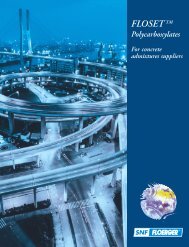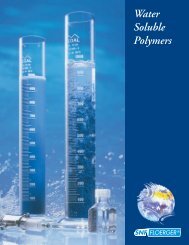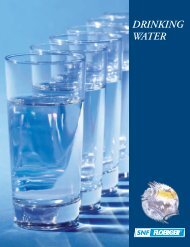SLUDGE DEWATERING - SNF Group
SLUDGE DEWATERING - SNF Group
SLUDGE DEWATERING - SNF Group
Create successful ePaper yourself
Turn your PDF publications into a flip-book with our unique Google optimized e-Paper software.
R I N G<br />
Several parameters, specific to centrifuge dewatering, should be considered since they<br />
affect on the polymer selection during lab tests and industrial trials.<br />
● Diaphragm diameter:<br />
This parameter corresponds to the diameter of the centrate exit hole. It is controlled by a<br />
series of plates that can be adjusted in height. Inside the bowl a liquid ring is created, its<br />
thickness is equal to the distance between the bowl’s surface and the edge of the plate.<br />
The smaller the diaphragm diameter, the thicker the liquid ring.<br />
The diaphragm diameter is selected to obtain the best compromise between centrate<br />
clarification and sludge dryness.<br />
● Relative speed:<br />
The relative speed is the difference in rotation speeds between the bowl and the central<br />
Archimedean screw. The higher the relative speed, the faster the sludge is extracted.<br />
● Torque:<br />
The torque measures the pressure of the sludge on the screw. This pressure creates torsion<br />
on the screw axis. This torsion is measured to give the torque. The higher the sludge pressure<br />
on the screw, the higher the torque.<br />
Note: This is only one example of torque measurement.<br />
Torque and relative speed are linked. An increase of the relative speed will lower the torque<br />
and the sludge is extracted more quickly.<br />
High Performance Centrifuges increase sludge dryness. They have a different structure for<br />
the conveying screw that allows for a longer residence time in the centrifuge.<br />
5.2. Lab tests:<br />
5.2.1. Sampling:<br />
Of the solution to be treated:<br />
A representative sample of the sludge must be taken. In order to achieve this, the sample<br />
will be taken just before the polymer injection point and the lab tests will be executed rapidly<br />
after sampling (the sludge condition may change over time).<br />
An analysis of the Dry Solids content (DS) of the sludge must be made since the polymer<br />
dosage is a function of the DS.<br />
Of the polymer:<br />
It is not necessary to test all the products available (more than 200 for dewatering applications),<br />
a primary screening will do. Select the ionic charge by testing a range of products with<br />
the same molecular weight: FLOPAM AN 900 SH Series for the anionic powders and FLO-<br />
PAM FO 4000 SH for the cationic powders.<br />
centrifuge dewatering<br />
23






